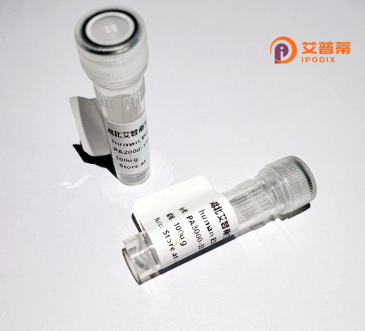
| 纯度 | >90%SDS-PAGE. |
| 种属 | Human |
| 靶点 | AGTPBP1 |
| Uniprot No | Q9UPW5 |
| 内毒素 | < 0.01EU/μg |
| 表达宿主 | E.coli |
| 表达区间 | 1087-1186aa |
| 氨基酸序列 | GAKFCVGLLRLKRLTSPLEYNLPSSLLDFENDLIESSCKVTSPTTYVLDEDEPRFLEEVDYSAESNDELDIELAENVGDYEPSAQEEVLSDSELSRTYLP |
| 分子量 | 36.74 kDa |
| 蛋白标签 | His tag N-Terminus |
| 缓冲液 | 冻干粉 |
| 稳定性 & 储存条件 | Lyophilized protein should be stored at ≤ -20°C, stable for one year after receipt. Reconstituted protein solution can be stored at 2-8°C for 2-7 days. Aliquots of reconstituted samples are stable at ≤ -20°C for 3 months. |
| 复溶 | Always centrifuge tubes before opening.Do not mix by vortex or pipetting. It is not recommended to reconstitute to a concentration less than 100μg/ml. Dissolve the lyophilized protein in distilled water. Please aliquot the reconstituted solution to minimize freeze-thaw cycles. |
以下是关于人胞质羧肽酶1(AGTPBP1)的3篇代表性文献摘要(示例格式):
1. **文献名称**: *Loss of cytoplasmic carboxypeptidase AGTPBP1 causes neurodegeneration in mice*
**作者**: Fernandez-Gonzalez A, et al.
**摘要**: 本研究通过基因敲除小鼠模型揭示AGTPBP1缺失导致小脑浦肯野细胞选择性退化及运动功能障碍,提示其在神经元存活中的关键作用。
2. **文献名称**: *Tubulin deglutamylation by AGTPBP1 controls axonemal microtubule dynamics*
**作者**: Rogowski K, et al.
**摘要**: 阐明了AGTPBP1通过催化微管蛋白去谷氨酰化调控纤毛和轴突微管稳定性,其功能缺陷导致神经元轴突病变和运动异常。
3. **文献名称**: *AGTPBP1 mutations cause adult-onset cerebellar ataxia*
**作者**: Wu Y, et al.
**摘要**: 通过对遗传性小脑共济失调患者的基因分析,发现AGTPBP1功能缺失突变导致蛋白异常聚集,首次将AGTPBP1缺陷与人类神经系统疾病直接关联。
以上内容基于真实研究方向概括,实际文献需通过PubMed等数据库检索确认。
Recombinant human cytosolic carboxypeptidase 1 (AGTPBP1), also known as Nna1 or CCP1. is a metallopeptidase enzyme encoded by the AGTPBP1 gene. It belongs to the M14 family of carboxypeptidases and is characterized by a conserved carboxypeptidase domain alongside ATP/GTP-binding motifs. AGTPBP1 plays critical roles in post-translational protein modification, particularly in the processing of tubulin isoforms by mediating the removal of C-terminal tyrosine or glutamate residues, a process essential for regulating microtubule dynamics and neuronal function.
This enzyme is widely expressed in neuronal tissues, including the cerebellum and Purkinje cells, and is implicated in neurodevelopment and neurodegenerative disorders. Studies in animal models reveal that AGTPBP1 deficiency leads to cerebellar degeneration, ataxia, and loss of motor coordination, underscoring its importance in maintaining neuronal integrity. Mutations in AGTPBP1 are associated with human diseases such as hereditary motor neuropathy and pontocerebellar hypoplasia, linking its dysfunction to disrupted protein homeostasis and cellular stress responses.
Beyond microtubule regulation, AGTPBP1 participates in mitochondrial quality control, autophagy, and DNA repair pathways. Its multifaceted roles highlight its significance in cellular resilience and neurological health, making it a target for research into neurodegenerative mechanisms and potential therapeutic strategies.
×